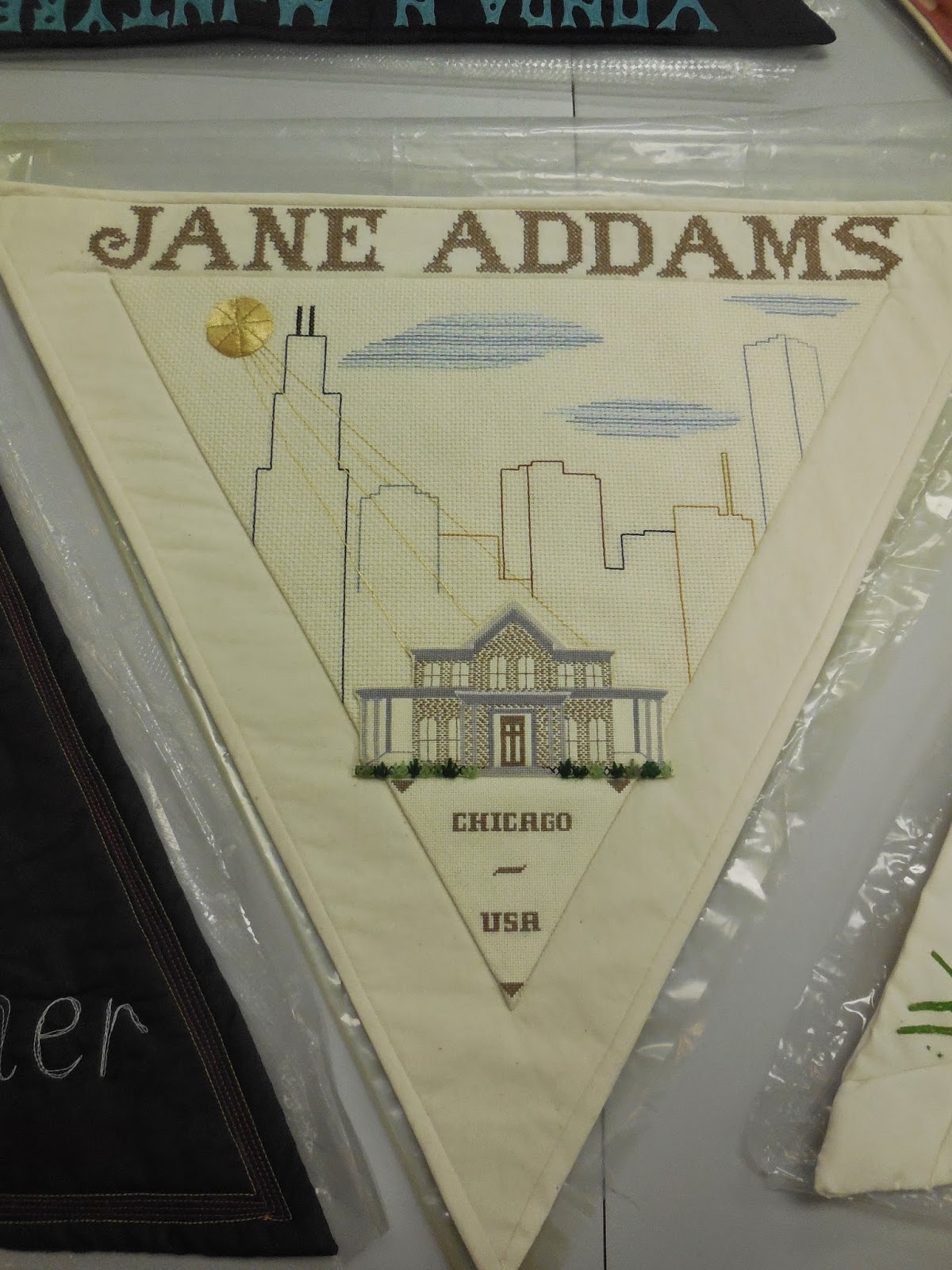Tuesday, December 9, 2014
My new "day job" 2
When I learned last summer that the University of Louisville School of Art had acquired the panels made by hundreds of volunteers to accompany Judy Chicago's The Dinner Party, my heart sank. I had two major concerns.
First, I was afraid that the panels would be portrayed as works of art, even though I suspected that many of them would have that loving-hands-at-home air -- exhibiting neither excellent craft nor compelling visual imagery -- that is the antithesis of serious fiber art. I was afraid that such an endorsement would taint the air, at least locally, and make it easier for people to lump all fiber art into the same shallow bucket, awash in earnest sentimentality.
Second, I was annoyed that the collection was officially named the International Honor Quilt, even though many of the pieces in my first viewing were not quilts. It's the same quarrel I have with the "AIDS Quilt;" it chops me that the "most famous quilt in the world" is not a quilt, because that disrespects the many works that truly are quilts and encourages people to be haphazard in how they talk about all fiber art and textile techniques. (Chicago was also involved in the genesis of the AIDS Quilt, so perhaps her cavalier attitude toward nomenclature affected both projects.)
not a quilt
When my fiber and textile art group met with the curators in August and got to see some of the panels, I raised this issue of nomenclature. It didn't get much response from the curators, none of whom had much experience with fiber art, until I said, "I know that you must be really annoyed when people refer to your work incorrectly, using the terms 'painting' and 'print' interchangeably." (Winces from the other side of the table; laughter from the assembly.) "Well, that's the same way I feel when people don't use the term 'quilt' correctly -- it's like fingernails on the blackboard."
But I left the meeting with a feeling that the best -- perhaps the only -- way to be sure my concerns didn't become unpleasant realities was to get involved myself. I was reassured that the curators had backed away from the earliest PR-release language touting the collection as "an artistic treasure" and were viewing it more as a sociological event, a remarkable outpouring of response from women around the world, embodying the ardent feminism that today seems quaint.
not a quilt
And I was determined to honor the work of these women by describing it correctly. The curators said at the meeting that they hoped to get volunteer help from our textile group in the cataloguing, and I immodestly thought that I probably had as wide a knowledge of textile techniques as anybody else in the group. So I told the professor in charge of the project to count me in.
Subscribe to:
Post Comments (Atom)









This is fascinating. I so agree with you about the annoyance of mis-described work. My personal bugbear is the description of the Bayeux Embroidery as a tapestry - made worse by the recent magnificent embroidery of the history of Scotland also being called a tapestry. Like you I think of these as being social manifestations.
ReplyDeleteGood luck, and I look forward to reading of your adventures.
Interesting project -- how to best describe and catalogue the contributions? As long as we are talking about terminology, though, I would say that I would not describe second-wave feminism as quaint. When I look at the feminist movement in all its eras, I am deeply moved and impressed by the vital and difficult work of feminist activists. I am heartened and emboldened by their efforts. While it is true that current feminist thought differs in some ways from those of earlier eras, there are still important lessons to be learned from the work done by earlier feminists. I am proud to be a feminist, and I am proud of the work done by the feminists who came before me.
ReplyDeleteDeborah -- I agree with you, proud to be a feminist, proud of the work done by those who came before me (or in many cases, with me). I am disappointed in how feminism has become a bad, old-fashioned word and especially in how young women today seem to think it's passe and unnecessary to stand up for their rights. "Quaint" might not be the perfect word, but doesn't it seem as though those days of the 70s and 80s are a l-o-n-g way off?
DeleteI know what you mean -- why should feminism be a bad word? It's interesting that, although the majority of Americans support the fundamental goals of feminism, most don't self-identify as feminist. I think that is largely due to stereotyping and misunderstanding of feminism; in fact, negative stereotypes of feminists today are similar to those that emerged in the suffrage movement. So, yes, it may feel as though earlier eras are a long way off, but there is also a remarkable degree of continuity in the feminist movement and the anti-feminist backlash.
DeleteI'm looking forward to hearing more about your project.
ReplyDeleteOh, my! I am so happy to hear that you are involved with this.
ReplyDelete